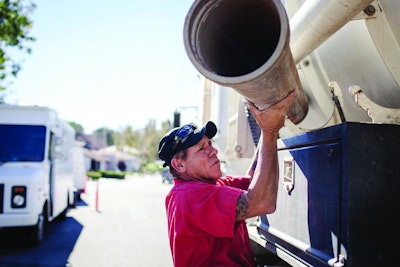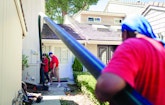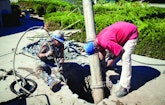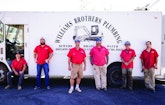
Interested in Cleaning?
Get Cleaning articles, news and videos right in your inbox! Sign up now.
Cleaning + Get AlertsWilliams Brothers Plumbing is perfectly positioned to capitalize on its expertise. In Southern California – where the business is located – roots and badly deteriorating pipe have led to big problems, especially in lateral lines. Those problems create a huge demand for trenchless pipe rehabilitation, which just so happens to be the company’s specialty.
Many of the houses in the Los Angeles County communities the business serves were built in the 1970s with Orangeburg lateral lines, cast iron inside the home and clay in the street. Orangeburg was an inexpensive product, and 40-plus years after installation, the sewer systems are in dire need of replacement. Manager Joe Williams says roots go through the pipe like soft butter.
“It is paper lined with tar, and the idea is tar is waterproof and roots will not grow through,” he says. “It seemed the perfect product, but with water constantly running, the tar was washed away. The lift stations received an abundance of tar, and pumps were failing. They began to find the sewers were left with paper but no more tar. Roots ran through, and the pipes just collapsed.”
Williams says trenchless replacement is much easier with Orangeburg than with heavier lines such as plastic, which are typically 4-inch lines, 6 to 8 feet deep. The average length of a residential lateral line is 70 feet.
Williams points out that many of the trees and shrubs planted in these upper-income neighborhoods are not native to Southern California’s desert region. The plants are not conditioned to the climate, so their roots continually seek water, growing and spreading until they find a source, which is often a sewer line.
Recession repercussions
Established in 1980, the Thousand Oaks, Calif.-based company nearly retired its Bobcat about 20 years ago after it began using pipe bursting systems from HammerHead Trenchless Equipment. Pipe bursting makes up a significant portion of the business, and the firm has continued to update equipment as refinements come along.
By 2005, Williams Brothers was a booming operation, with 14 to 16 employees rehabilitating two sewer lines a day. However, business slowed significantly and abruptly during the Great Recession and they had to reduce staff.
Eventually, entrepreneurs began purchasing and flipping properties that had sat empty for six months or more. As new homeowners moved in, sewer system problems were uncovered. The roots that had enjoyed the water in the sewers were going crazy looking for water. The systems were collapsing. This, of course, put Williams Brothers – and many of the plumbing companies they work for – back into a productive and busy period. The company had an opportunity to recover and grow again, and today they are handling at least one residential sewer replacement every working day of the year.
In addition to staff growth, Williams Brothers has also added new equipment, including a 4,000 psi/18 gpm trailer jetter from US Jetting and a 2006 Vac-Con on an International chassis. The unit produces 3,000 psi/10 gpm and features a 1,000-gallon plastic water tank, an 8-yard debris tank and an 8-inch boom powered by two blower motors. The truck is primarily used for hydroexcavating around utilities, and Williams says the 8-yard tank is sufficient for most jobs.
The company also purchased Oaks Drain Service, which provides basic plumbing services. Williams Brothers remains the flagship of the operation, but employees work for both entities.
Changing with the times
As the demand for sewer replacement grows in the towns of Thousand Oaks, Agoura Hills, Newbury Park and Simi Valley, Williams Brothers subcontracts for more plumbing companies that do not provide trenchless rehabilitation services. Williams estimates 30 percent of daily business comes from this important segment.
“These companies have no problem having us on the site of their customer,” he says. “We give them a price and they deal with their customer. They just tell them that we are the guys they work with. They know we will not attempt to steal their customers.”
Because the company has been in the area so long, its name is well recognized and the business receives many calls directly. Williams says word of mouth continues to be the best advertising tool. He likes Angie’s List because members pay to be listed there, which he says gives them “skin in the game.”
“We also work with many homeowner associations dealing with these issues here in our area,” he says. “Also we have dealings with Realtors and home inspectors who more and more want to have a sewer line inspected before a sale.”
When inspections are called for, Williams Brothers gets the job done with RIDGID SeeSnake Compact 2 CCTV cameras.
“Until recently, people were not inspecting sewer lines. A home would sell, and then there would be problems in the line. Everyone would be upset. These inspections are more important when the homes have been sitting empty for a long period of time.”
He says the company’s website has been a good way to communicate that message to consumers, associations and plumbing companies.
Relay the message
Educating the consumer is part of the package. Williams says pipe bursting is something a person almost has to see to believe.
“Occasionally, a prospective customer just doesn’t care. He or she just wants the system fixed. Those who are interested can see what is going on with the video camera. The technicians will fully explain – show the roots in the line, describe the process, where the holes will be dug. If they want more clarification they can go to our website and view the line being pulled.”
There are still nonbelievers – the homeowner or plumber who says he will do it the old-fashioned way – and Williams is fine with that.
“They can pay to have their lawn dug up and a trench dug, and then replace the lawn. So be it,” Williams says. “We do the inspection, video the lines, tell them what we can do. Then they can decide.”
Valuing talent and training
Training technicians to fill these positions is an important financial investment.
“We are specialists,” Williams says. “If you hire a plumber, you can send that person out on a job. We do our training for trenchless technicians on site. A candidate will go out with another driver for up to two months of training. We want to provide a good education and have a candidate know how we do the process.”
For trenchless sewer replacement, the company typically dispatches a four-man crew. Lines are marked with RIDGID NaviTrack Scout locators before any digging takes place. Two technicians are stationed at the top hole by the house and two at the bottom hole where the line connects to the main. The Vac-Con is positioned at the bottom hole, which is typically 6 feet deep. The men at the top hole hand-dig a 3-foot hole. Both are completed at about the same time.
The bursting process takes place while the Vac-Con drives away to dump the dirt. There are no soil piles at the site. After the new line is in place, the sand truck (2006 International chassis with a roll-off bin) dumps sand into the bottom hole and puts sod back on top while they hand-fill at the top hole.
If Williams Brothers can coordinate with an inspector, the entire process can be completed in one day.
Williams says in an emergency situation, the business might tackle two jobs in a day. Typically though – until more technicians and equipment are added – the schedule works with one trenchless replacement per day. The crew is usually scheduled one week ahead, but as a 24/7 operation, they will respond to emergencies.
Satisfaction
Williams keeps a busy schedule, but he enjoys the work to which he’s dedicated his career. He says he’s seen the industry evolve, and can still remember being involved with the early prototypes from HammerHead.
Today, he says helping customers is what brings him the greatest satisfaction, even though it’s never fun to tell a customer they have a sewer problem they’re going to have to pay to fix.
“The biggest bummer is when you see the customer in a real heartache about it. The sewer is backing up into the home and there is nothing they can do about it personally. I like to be the one who holds their hand and then walks them through it. Solving that problem is satisfying. We share their concern from the first phone call until we have things working again.”
More Information
HammerHead Trenchless Equipment - 800/331-6653 - www.hammerheadtrenchless.com
RIDGID - 800/769-7743 - www.ridgid.com
US Jetting, LLC - 800/538-8464 - www.usjetting.com
Vac-Con, Inc. - 855/336-2962 - www.vac-con.com












